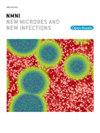南非一家三级医院儿科住院十年无菌部位微生物的微生物学概况和培养阳性率:中低收入国家的视角
IF 5.4
Q2 INFECTIOUS DISEASES
引用次数: 0
摘要
无菌部位(血液和脑脊液)感染是儿童发病和死亡的重要原因。本研究旨在确定来自中低收入国家的儿科住院患者的病原微生物、抗菌素耐药性模式和败血症趋势率。方法回顾性分析2013年1月至2022年12月南非Chris Hani Baragwanath学术医院新生儿病房(NNU)、普通儿科病房(GPW)和儿科血液肿瘤科病房(PHOW)住院患者的SS培养结果。结果共检出SS标本58 053份。培养阳性率36.0%,其中病原菌阳性率22.8%,污染物阳性率13.2%。NNU的病原菌培养阳性率高于GPW (35.5% vs 17.6%; OR-5.38; 95% CI 4.99 ~ 5.81),但低于GPW (35.5% vs 46.6%; OR-0.47; 95% CI 0.39 ~ 0.52)。每1000个病人日的感染率从2013年的1.74上升到2022年的3.11。革兰氏阴性菌(GNB)(66.0%比18.7%,OR-5.70; 95% CI 5.23-6.19)和酵母菌(12.4%比8.4%,OR-7.66; 95% CI 6.13-9.57)在NNU中比GPW中更常见。多药耐药(MDR)病原菌患病率为35.1%,其中广谱β -内酰胺酶肠杆菌占40 - 50%。碳青霉烯耐药不动杆菌种类从2013年的40%增加到2022年的60% (p = 0.004)。MRSA患病率从2013年的30%下降到2022年的10% (p = 0.004)。结论儿童耐多药革兰氏阴性SS感染负担较高,需要持续监测、合理使用抗菌药物,同时加强感染控制和接触传播预防。应进一步研究抗菌素耐药性的驱动因素,如单位特定抗菌素消费率和开处方者的做法。本文章由计算机程序翻译,如有差异,请以英文原文为准。
Microbiological profile of sterile site organisms and culture positivity rates from a decade of paediatric admissions at a tertiary hospital in South Africa: A lower and middle-income country perspective
Background
Sterile site (SS (blood and cerebrospinal fluid)) infections are formidable causes of childhood morbidity and fatality. This study aimed to determine aetiological organisms, antimicrobial resistance patterns and sepsis trend rates in paediatric inpatients from a low-and middle-income country.
Methods
A retrospective review of SS culture results of inpatients from the neonatal unit (NNU), general paediatric (GPW) and paediatric haematology-oncology wards (PHOW) at Chris Hani Baragwanath Academic Hospital, South Africa, from January 2013 to December 2022.
Results
A total of 58 053 SS specimens were submitted for analysis. Culture-positivity rate was 36.0 %, comprising 22.8 % and 13.2 % for pathogens and contaminants. Pathogen culture-positivity rate was higher in the NNU when compared to GPW (35.5 % vs 17.6 %; OR–5.38; 95 % CI 4.99–5.81) but lower than PHOW (35.5 % vs 46.6 %; OR-0.47; 95 % CI 0.39–0.52). Infection rates per 1000 patient-days increased from 1.74 in 2013 to 3.11 in 2022. Gram-negative bacteria (GNB) (66.0 % vs 18.7 %, OR-5.70; 95 % CI 5.23–6.19) and yeast (12.4 % vs 8.4 %, OR-7.66; 95 % CI 6.13–9.57) were more common in NNU than GPW. Multidrug-resistant (MDR) pathogen prevalence was 35.1 % with extended-spectrum beta-lactamase Enterobacterales contributing 40–50 %. Carbapenem-resistant Acinetobacter species increased from 40 % to 60 % from 2013 to 2022 (p = 0.004). MRSA prevalence decreased from 30 % to 10 % from 2013 to 2022 (p = 0.004).
Conclusion
The burden of paediatric MDR gram-negative SS infection was relatively high requiring ongoing surveillance, judicious antimicrobial use, while reinforcing infection control contact-based transmission precautions. Further studies on drivers of antimicrobial resistance such as unit specific antimicrobial consumption rates and prescriber practices, should be explored.
求助全文
通过发布文献求助,成功后即可免费获取论文全文。
去求助
来源期刊

New Microbes and New Infections
Medicine-Infectious Diseases
CiteScore
10.00
自引率
2.50%
发文量
91
审稿时长
114 days
 求助内容:
求助内容: 应助结果提醒方式:
应助结果提醒方式:


